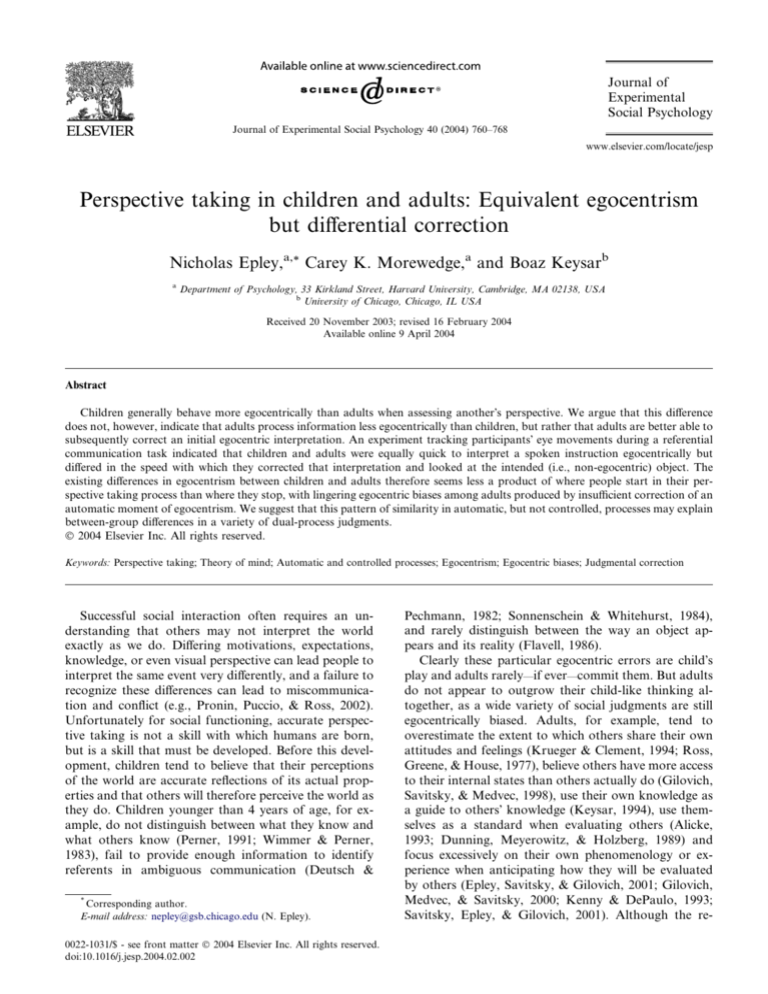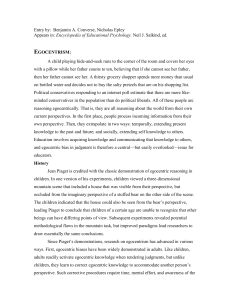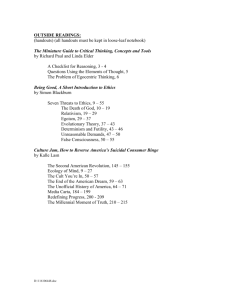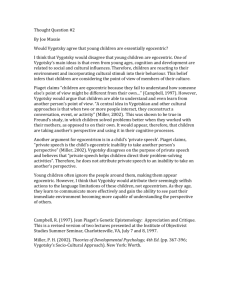
Journal of
Experimental
Social Psychology
Journal of Experimental Social Psychology 40 (2004) 760–768
www.elsevier.com/locate/jesp
Perspective taking in children and adults: Equivalent egocentrism
but differential correction
Nicholas Epley,a,* Carey K. Morewedge,a and Boaz Keysarb
a
Department of Psychology, 33 Kirkland Street, Harvard University, Cambridge, MA 02138, USA
b
University of Chicago, Chicago, IL USA
Received 20 November 2003; revised 16 February 2004
Available online 9 April 2004
Abstract
Children generally behave more egocentrically than adults when assessing anotherÕs perspective. We argue that this difference
does not, however, indicate that adults process information less egocentrically than children, but rather that adults are better able to
subsequently correct an initial egocentric interpretation. An experiment tracking participantsÕ eye movements during a referential
communication task indicated that children and adults were equally quick to interpret a spoken instruction egocentrically but
differed in the speed with which they corrected that interpretation and looked at the intended (i.e., non-egocentric) object. The
existing differences in egocentrism between children and adults therefore seems less a product of where people start in their perspective taking process than where they stop, with lingering egocentric biases among adults produced by insufficient correction of an
automatic moment of egocentrism. We suggest that this pattern of similarity in automatic, but not controlled, processes may explain
between-group differences in a variety of dual-process judgments.
Ó 2004 Elsevier Inc. All rights reserved.
Keywords: Perspective taking; Theory of mind; Automatic and controlled processes; Egocentrism; Egocentric biases; Judgmental correction
Successful social interaction often requires an understanding that others may not interpret the world
exactly as we do. Differing motivations, expectations,
knowledge, or even visual perspective can lead people to
interpret the same event very differently, and a failure to
recognize these differences can lead to miscommunication and conflict (e.g., Pronin, Puccio, & Ross, 2002).
Unfortunately for social functioning, accurate perspective taking is not a skill with which humans are born,
but is a skill that must be developed. Before this development, children tend to believe that their perceptions
of the world are accurate reflections of its actual properties and that others will therefore perceive the world as
they do. Children younger than 4 years of age, for example, do not distinguish between what they know and
what others know (Perner, 1991; Wimmer & Perner,
1983), fail to provide enough information to identify
referents in ambiguous communication (Deutsch &
*
Corresponding author.
E-mail address: nepley@gsb.chicago.edu (N. Epley).
0022-1031/$ - see front matter Ó 2004 Elsevier Inc. All rights reserved.
doi:10.1016/j.jesp.2004.02.002
Pechmann, 1982; Sonnenschein & Whitehurst, 1984),
and rarely distinguish between the way an object appears and its reality (Flavell, 1986).
Clearly these particular egocentric errors are childÕs
play and adults rarely—if ever—commit them. But adults
do not appear to outgrow their child-like thinking altogether, as a wide variety of social judgments are still
egocentrically biased. Adults, for example, tend to
overestimate the extent to which others share their own
attitudes and feelings (Krueger & Clement, 1994; Ross,
Greene, & House, 1977), believe others have more access
to their internal states than others actually do (Gilovich,
Savitsky, & Medvec, 1998), use their own knowledge as
a guide to othersÕ knowledge (Keysar, 1994), use themselves as a standard when evaluating others (Alicke,
1993; Dunning, Meyerowitz, & Holzberg, 1989) and
focus excessively on their own phenomenology or experience when anticipating how they will be evaluated
by others (Epley, Savitsky, & Gilovich, 2001; Gilovich,
Medvec, & Savitsky, 2000; Kenny & DePaulo, 1993;
Savitsky, Epley, & Gilovich, 2001). Although the re-
N. Epley et al. / Journal of Experimental Social Psychology 40 (2004) 760–768
search that established these phenomena did not contrast children with adults, it does demonstrate that
egocentrism is not merely a passing phase of childhood,
but a fact of life.
In this article we seek to explain why egocentric biases
in adults are less common than in children—but by no
means absent—by comparing the time course of social
cognition in children and adults. At least two explanations seem plausible. First, adults may be less egocentric
than children because they are less likely to use their own
perspective when assessing anotherÕs interpretation, and
instead rely on an entirely different psychological process
for perspective taking. Over time, adults may acquire
domain specific theories or prototypes about how other
minds work that are applied when adopting anotherÕs
perspective in much the same way that a person applies a
formula when solving math problems (Gopnik & Wellman, 1992; Karniol, 2003). With repeated experience,
adults come to learn that their perceptions may differ
from others in specific ways. Once those ways are known,
they replace theories based on oneÕs own unique perspective. Adults may be less egocentric than children,
quite simply, because they tend to apply less egocentric
theories when adopting anotherÕs perspective (Elkind,
1967; Flavell, 1992; Piaget, 1959).
A second possibility is that adults and children share
an automatic egocentric default in perspective taking
that adults, over time, become better at correcting when
necessary. Adults are less egocentric than children on
this account, not because they are less likely to automatically interpret their perceptions egocentrically, but
rather because they are better at effortfully correcting
that initial interpretation in a subsequent processing
stage to accommodate differences between their own
perspective and anotherÕs perspective. This dual-process
account of adult perspective taking suggests that egocentrism isnÕt outgrown so much as it is overcome each
time a person attempts to adopt anotherÕs perspective
(Nickerson, 1999).
As with other dual-process accounts of human judgment, the automatic default occurs quickly and rapidly
whereas the corrective process must be activated by
motivation and sustained by attention. As a result,
corrections are notoriously incomplete and outcomes
consistently biased in the direction of the default or
‘‘anchor’’ (Epley & Gilovich, 2004; Gilbert, 1989; Gilbert & Gill, 2000; Trope & Gaunt, 2000). Egocentric
biases are therefore the product of insufficient correction, and the differences in perspective taking between
children and adults on this account are a matter of degree, rather than kind.
These two general views of perspective taking make
different predictions about the time course of social
cognition in children and adults. The theory-driven account suggests that children and adults engage in different mental operations when adopting the perspective
761
of another, with children applying more egocentric
theories than adults. The egocentric-correction account,
in contrast, suggests that adults and children do not
differ in their initial egocentric interpretation, but in the
speed and effectiveness with which they overcome that
interpretation. Differences in egocentric biases by this
correction account are produced by the subsequent
ability to correct or modify an egocentric interpretation,
not by differences in the initial tendency to make one.
We tested these different predictions by tracking
children and adultsÕ eye movements as they completed a
perspective taking task. The task was a referential
communication game in which participants were directed by an experimental confederate to move objects
around an upright array of boxes (see Fig. 1). The
participant and confederate—hereafter, the ‘‘director’’—
were seated on opposite sides of the array and the directorÕs (ostensible) task was to instruct the participant
to move objects into a new arrangement provided by the
experimenter. Some of the objects were occluded from
the directorÕs view by a wooden slat but were still observable to the participant, creating a critical difference
in their visual perspective. Any egocentric tendency in
interpreting the instructions would be evidenced when
participants consider objects that are visible only to
them—exactly as participants did in previous experiments (Keysar, Barr, Balin, & Brauner, 2000; Keysar,
Lin, & Barr, 2003). The inclusion of children in the
current experiment moves beyond previous work by
directly investigating the etiology of perspective taking
differences in children and adults.
On critical trials, the director referred to an ambiguous object from the participantÕs perspective. Consider
the example in Fig. 1. The participant on this trial can
see three trucks, but can also see that the director sitting
on the other side can only see two. When the director
asks the participant to move the small truck, he can only
be referring to the truck that is medium sized from the
participantÕs perspective (second row, far left, from the
participantÕs view). But to the extent that participants
are even temporarily egocentric, they should automatically consider the hidden, smaller truck as a referent
(middle row, far right, from the participantÕs view).
To evaluate whether participants initially entertained
an egocentric interpretation, we recorded the object they
moved. More important, we also measured the speed with
which their eyes fixated on either the hidden or the intended object. Eye-fixations provide a unobtrusive
method for tracking on-line cognition, and is well accepted as a valid indicator of information processing and
attention (Rayner, 1998; Tannenhaus, Magnuson, Dahan, & Chambers, 2000; Tannenhaus, Spivey-Knowlton,
Eberhard, & Sedivy, 1996). Eye movements track linguistic processing while reading (Rayner, 1998), reveal
interference between languages among bilinguals (Spivey
& Marian, 1999), follow the logical causal sequence in
762
N. Epley et al. / Journal of Experimental Social Psychology 40 (2004) 760–768
Fig. 1. Array of objects, including both occluded and mutually observable objects, from the participantÕs and directorÕs perspective. (The critical
instruction from the director on this trial was to ‘‘move the small truck above the glue.’’)
problem-solving tasks and correlate with solution accuracy (Hegarty, 1992; Rozenblit, Spivey, & Wojslawowicz,
2002), and tightly track objects in the environment discussed during the course of conversation (Cooper, 1974;
Tannenhaus, Spivey-Knowlton, Eberhard, & Sedivy,
1995). In addition, guiding visual attention to relevant
information during a problem solving task substantially
influences reasoning and performance (Grant & Spivey,
2003). Not only do people look at objects about which
they are thinking, but they also think about objects at
which they are looking. In the current experiments, the
speed with which participants fixate their eyes on a target
can be interpreted as the speed with which they consider
an object as a possible referent (Keysar et al., 2000; Spivey
& Tannenhaus, 1998).
Based on previous investigations of perspective taking
in both children (Flavell, 1992; Piaget, 1959) and adults
(Epley, Keysar, Van Boven, & Gilovich, in press; Keysar
et al., 2000), we made three predictions. First, children
would make more egocentric reaching errors than adults,
replicating much past research demonstrating greater
egocentric biases in children than adults. Second, adults
and children would not differ in the speed with which
they initially formed an egocentric interpretation of an
instruction (after controlling for baseline differences in
looking speed). Third, and most important, adults would
be faster to correct this egocentric interpretation and
therefore look at the correct object (the mutually observable truck) more quickly. If confirmed, these results
would suggest that differences in egocentric biases between children and adults are produced by variance in
controlled, rather than automatic, mental processes.
Method
Participants
Children (13 males and 20 females, mean age ¼ 6.2
years, median age ¼ 5.0 years, range ¼ 4–12 years)1 and
their parents (12 males and 20 females) who were visiting the ChildrenÕs Museum of Boston participated in
exchange for a free pass to the Museum. A larger than
usual age range of children was recruited to allow for the
possibility of internal analyses within this sample. Four
additional children and 5 parents were recruited but did
not finish the session, either because they were unwilling
to participate (n ¼ 3 children), because they were repeatedly distracted (n ¼ 4 parents), or because they
failed to follow the experimenterÕs instructions (n ¼ 1
child and 1 parent). To retain as much data as possible,
all data are analyzed at the level of the individual rather
than the pair.2
1
We tried to restrict our recruited sample to those from 4 to 7
years old, and 74% of our sample fell within that range. Of the
remaining children, four were 8 years old, one was 9, two were 10, one
was 11, and one was 12. Removing these older children somewhat
strengthens the results of this experiment, although not meaningfully
so. All children are retained for the sake of completeness, and to allow
for subsequent analyses across age within the child sample.
2
Analyzing the data at the level of pair does not diminish the
validity of our conclusions in any way. In fact, it increases the
significance levels of every relevant test due to the increased power of
repeated-measures analyses.
N. Epley et al. / Journal of Experimental Social Psychology 40 (2004) 760–768
Apparatus
Participants were instructed by the director to move
objects around a 5 5 upright array of boxes, four of
which were occluded from the directorÕs view by a
wooden cover but were clearly observable to participants
(see Fig. 1). ParticipantsÕ eye movements were recorded
by a Sony DCR-PC9 digital video camera positioned in
the center of the second row from the top, focused on the
participantsÕ eyes. Both adults and children were propped up on pillows or a small stool, as necessary, to ensure
their eyes were level with the camera and centered on the
array. This camera was approximately 20 in. from participantsÕ heads and provided 33 ms snapshots of their
eye movements. A second video camera located to the
participantsÕ left recorded their reaching.
Procedure
In each session, one parent and (ideally) one child
were escorted to a room away from the MuseumÕs main
activities and introduced to a male confederate who
would be assisting with the experiment as the ‘‘director.’’
The experimenter stressed that the director did not
know anything about the specific trials to be presented
in this session, and was functionally in the same position
as the participants themselves.
All participants were told their task was to move objects around a 5 5 array of boxes as instructed by the
director, who would be seated on the opposite side of the
array. At the beginning of each trial, objects would be
placed in the array and the director given a picture with
some of the objects in different positions. The director
would instruct participants to move objects from their
initial positions in the grid to the final positions in his
picture. After learning these details, participants (both
the parent and the child simultaneously) performed a
practice trial from the directorÕs position to ensure they
understood his task and the visual occlusions. The experimenter pointed out the boxes covered by a wooden
slat during the practice trial, and that objects behind the
slats could not be seen by the director. To make the occlusion especially clear, the director played the role of the
participant during this practice trial and committed one
egocentric reaching error and was immediately corrected
by the experimenter.
Once finished playing the role of the director, the
child in each pair was placed in the participantsÕ position. The parent was seated with his or her back to the
experimental set-up and asked to wear soundproof
earmuffs to ensure that he or she could neither see nor
hear their childÕs session. Children participated first due
to the obvious difficulties of isolating them from their
parentÕs session in a similar fashion.
At the beginning of each trial, a black sheet was
dropped over the directorÕs side of the array to block his
763
view. The experimenter then placed the objects into the
array on the participantÕs side, raised the sheet, and gave
the director a picture of the objectsÕ final positions (from
the directorÕs perspective, with hidden boxes occluded).
Participants were told to look directly into the camera
located in the center of the array before each instruction
in order to standardize participantsÕ eye gaze at the beginning of each trial.
Each experimental session consisted of four trials for
both the parent and child, and each trial involved four
separate instructions to move an object. Within each
trial, one critical instruction could refer to only one
object from the directorÕs view, but could refer to two
objects from the participantÕs view. For example, the
critical instruction in Fig. 1 was ‘‘please move the small
truck above the glue.’’ The smallest of the 3 trucks in the
participantÕs view was occluded from the directorÕs view,
meaning he was actually referring to what appeared to
the participants as the medium sized truck. The other
three instructions in each trial referred to mutually observable objects.
To increase the generalizability of our results, the
four critical instructions contained different forms of
ambiguity. Two utilized size ambiguity (‘‘move the
small truck’’ or ‘‘move the small candle’’ could refer
to the smaller of two mutually observable objects or
the smallest occluded object), one utilized spatial
ambiguity (‘‘move the bottom red ring’’ could refer
to one red ring stacked beneath an orange ring or an
occluded red ring positioned alone on the bottom
row of the display), and one utilized semantic ambiguity (‘‘move the bunny’’ could refer to either a
chocolate ‘‘Easter bunny’’ or an occluded stuffed
animal resembling a rabbit). The position of the
critical instruction within each trial varied in a predetermined random fashion; it came last (out of 4) in
the first trial, third in the second trial, first in the
third trial, and second in the last trial.
On each trial, the target and egocentric objects were
placed on opposite sides of the camera, making the
object of attention and reaching easy to discern. Two
raters unaware of our hypotheses coded the eye movements (r ¼ :77, p < :001) and reaching behavior on the
critical trials (r ¼ :88, p < :001). Because adults and
childrenÕs behavior can differ in a way that is independent of our manipulation, we used control (filler) trials
containing no ambiguous instructions as a baseline
measure. Two additional coders coded looking and
reaching for trials that were closest to the critical trials,
namely either immediately following the critical instruction (on the trial in which the critical instruction
was first) or preceding the critical instruction (on the
remaining 3 trials;, rðlookingÞ ¼ :79, p < :001, rðreachingÞ ¼
:92, p < :001). The speed with which participants looked
at, and reached for, the objects were averaged together
between the two coders to create a single composite
764
N. Epley et al. / Journal of Experimental Social Psychology 40 (2004) 760–768
index, and disagreements on categorical measures were
resolved by a 3rd independent rater.
Eye movements and reaches were coded within a
temporal window that began at the end of the noun
phrase that identified the target (e.g., the small truck)
and ended when the participant touched an object. A
fixation was coded as any eye movement that remained
on a target for at least 3 video frames (99 ms).
Results
We predicted that adults would behave less egocentrically than children—making fewer egocentric reaching
errors—but that this difference would emerge only in
later stages of information processing. We predicted that
adults and children would not differ in their speed to
initially interpret an instruction egocentrically, but
would differ in their subsequent speed to adjust or correct that interpretation.
Reaching
As expected, children behaved more egocentrically
than adults when moving objects around the grid. Although adults committed a sizeable number of egocentric
reaching errors, they still committed far fewer reaching
errors than children. On the 4 critical instructions in
which the directorÕs description could have referred to the
hidden object, adults reached for the hidden object less
frequently than children (Ms ¼ 0:96 vs. 2.08, respectively), tð63Þ ¼ 4:40, p < :001. Reaching errors among
children were also significantly correlated with their age—
older children made fewer reaching errors than younger
children, rð31Þ ¼ :44, p < :05. These results are consistent with a variety of demonstrations that children behave
more egocentrically than adults, and are an important
precondition for the following analyses that address differences in the time course of social thought.
Looking
To test our prediction that these differences between
children and their parents were produced by a difference
in the ability to correct—rather than to make—an egocentric interpretation, we analyzed participantsÕ eye
movements across all trials to reveal processing that
foreshadows their hand movements. Because these reaction times were positively skewed, all reaction times
were logarithmically transformed. All analyses are performed on these transformed variables but untransformed means are presented in the figures to ease
interpretation.
Eye movements in filler trials described earlier served
as a measure of baseline speed. As can be seen in Fig. 2,
adults were generally faster to look at baseline target
Fig. 2. Mean latency (in milliseconds) from noun offset for children
and adults to fixate on the correct and hidden referents.
objects than children, tð63Þ ¼ 2:04, p < :05, and older
children tended to look more quickly at the target object
than younger children, rð31Þ ¼ :35, p < :05. These
differences establish an important baseline for our crucial comparisons. If adults are, as predicted, equally
quick to form an egocentric interpretation but faster
than their children to correct it, then this baseline difference in looking times between adults and children
should remain constant on the critical trials in the speed
with which participants look at the hidden (i.e., egocentric) object, but the difference in the speed with which
children and adults look at the correct (i.e., non-egocentric) object should increase.
Of key interest, therefore, was the relative speed with
which participants looked at the hidden and correct
objects on the critical instructions, controlling for
baseline difference in looking times. As shown in Fig. 2,
a 2 (Age: adult vs. child) 2 (Object: hidden vs. correct)
mixed model ANCOVA, with looking times on the
control trials as a covariate, yielded two main effects.
Adults again tended to look at objects more quickly
than children, F ð1; 62Þ ¼ 15:11, p < :01, and participants tended to look at the egocentric hidden object
more quickly than the mutually observable correct object, F ð1; 62Þ ¼ 11:03, p < :01. More important, these
main effects were qualified by the predicted interaction,
F ð1; 62Þ ¼ 10:83, p < :01.3 In fact, after controlling for
3
Excluding the baseline trials as a covariate and simply performing
a 2 (Age: adult vs. child) 2 (Object: hidden vs. correct) ANOVA with
repeated measures on the second factor produces conceptually
identical results. Both the main effect for age and object are significant,
F sð1; 63Þ ¼ 20:04 and 4.38, respectively, both ps < :05. More important, these two main effects were qualified by the predicted interaction,
F ð1; 63Þ ¼ 5:28, p < :05. Without correcting for baseline difference in
looking times on the critical trials, adults and children differed much
less in the speed with which they looked at the hidden object,
tð63Þ ¼ 1:84, p ¼ :07, than in the speed with which they looked at the
mutually observable correct object, tð63Þ ¼ 4:70, p < :01.
N. Epley et al. / Journal of Experimental Social Psychology 40 (2004) 760–768
Table 1
The relationship (for children and adults) between looking at the
egocentric hidden object during a critical trial and reaching for the
egocentric object
Reach
Do not reach
Children
Look
Do not look
51%
1%
32%
16%
Adults
Look
Do not look
21%
1%
61%
17%
Note. Data are the percentage of responses across all critical trials
corresponding to each category.
average baseline differences in looking times in the
control trials by subtracting them from the average
looking times on the critical trials, adults and children
did not differ in the speed with which they looked at the
egocentric object, t < 1, but still differed significantly in
the speed with which they looked at the mutually observable object, tð62Þ ¼ 4:34, p < :001.
Children and adults also did not differ in their tendency to consider the egocentric object as a potential
referent. Nearly all participants looked at the hidden
object on at least one of the 4 trials, and children
(M ¼ 83%) were no more likely to do so than adults,
(M ¼ 82%), t < 1. However, Table 1 shows that children
were significantly more likely than adults to reach for
the egocentric hidden object once they looked at it,
(Ms ¼ 51% and 21%, respectively), tð63Þ ¼ 4:91,
p < :001. These results demonstrate that adults were no
less likely than children to consider the egocentric object
as a possible referent, but were much more likely to
correct this egocentric consideration and refrain from
reaching for the hidden object.
Discussion
When communicating with others, Piaget argued, it is
as if children are ‘‘only talking to themselves’’ (1959, pp.
38). Most adults are better conversationalists because
they can recognize that their own perceptions may differ
from anotherÕs, and can tailor their interactions accordingly. Results from the current study suggest,
however, that adults and children may differ less in their
egocentric tendencies than it might initially appear. Both
adults and children quickly and automatically interpreted the directorÕs instructions egocentrically, and
differed only in the speed and effectiveness with which
they corrected this interpretation when it was clearly
inappropriate. These results suggest that egocentrism
isnÕt outgrown so much as it is overcome each time a
person attempts to adopt anotherÕs perspective. Far
from producing a radical shift in information processing, these results suggest that experience provides adults
765
the ability to talk with others only after recognizing that
they are not, in fact, talking to themselves.
The present experiment examined differences in automatic and controlled processes in perspective taking
by comparing the time course of information processing
between children and adults. The resulting pattern of
eye movements is consistent with a dual-process account
of adult perspective taking whereby information is initially processed egocentrically and then corrected or
adjusted to accommodate differences between oneÕs own
perspective and anotherÕs perspective. Because people
view the world through their own sensory organs, oneÕs
own perspective is readily accessible and generated automatically while anotherÕs perspective requires additional controlled processing. Adults and children do not
appear to differ in the automatic processing of their own
perspective but do differ in the controlled adjustment
required to accommodate anotherÕs differing perspective. Egocentric biases diminish but do not disappear
because such corrective procedures are not always activated, and when they are, tend to be terminated prematurely.
We report further evidence supporting this dualprocess account of adult perspective taking elsewhere in
which egocentric biases are increased when participants
are under attentional load and thus less able to correct
an egocentric interpretation, and decreased when participants are motivated to correct because of financial
incentives (Epley et al., in press, see also Gilbert & Gill,
2000). Thus, the egocentric biases are likely to increase
whenever the motivation to make an accurate judgment
is low, and decrease whenever motivation is high. These
findings mimic a variety of other social judgments that
have been explained by dual-process accounts including
dispositional inference (Gilbert, 2002), comparative
ability estimates (Kruger, 1999), preference reversals
(Lichtenstein & Slovic, 1971), probability estimates
(Plous, 1989; Wright & Anderson, 1989), affective forecasts (Gilbert, Gill, & Wilson, 2002), and retrospection
(Fischhoff & Beyth, 1975; Hawkins & Hastie, 1991).
Many of the biases commonly associated with these
judgments—such as the correspondence bias in dispositional inference—are also increased when the ability to
correct is hindered by attentional load (Gilbert, 1989;
Gilbert & Gill, 2000; Gilbert et al., 2002) and decreased
when the inclination to correct is enhanced by accuracy
motivation (DÕAgostino & Fincher-Kiefer, 1992). Given
the similarities between these apparent dual-process
judgments and adult perspective taking, it is possible
that a relationship similar to the one we observed between children and adults would be found in these other
judgments as well.
More generally, these results raise the interesting
possibility that between-group differences in dual-process judgments are more commonly produced by differences in controlled mental processes than by
766
N. Epley et al. / Journal of Experimental Social Psychology 40 (2004) 760–768
differences in automatic processes. For example, members from collectivistic cultures are less likely than
members from individualistic cultures to commit the
correspondence bias—to draw inferences about a personÕs dispositions from behavior that can be explained
by situational constraints (Gilbert & Malone, 1995).
This cultural difference, however, seems to result from
differences in the tendency to correct an automatic dispositional inference rather than in the automatic tendency to make a dispositional inference. Cross-cultural
differences in the attribution process occur only when
people have the cognitive resources available to engage
in situational correction, and disappear when perceivers
are under attentional load (Lieberman, Jarcho, &
Obayashi, 2004). Similar results have been found with
gender differences in sexual versus emotional jealousy—
differences that disappear when people are under attentional load, and therefore appear to be the product of
differences in controlled mental processes (DeSteno,
Bartlett, Braverman, & Salovey, 2002). Whether this
pattern of findings represent the rule or the exception in
human judgment is a fertile topic for future research.
Although our results clearly suggest that adults are
better able to correct an egocentric interpretation, it
remains to be seen exactly why this difference exists. One
of the hallmarks of effortful cognitive processes is that
they become more automatic and less attention-depleting with practice and experience. Even the most effortful
of cognitive processes can become more automatic with
repeated exposure and experience, and it is likely that a
lifetime of correcting an egocentric response to accommodate differing perspectives has made this process
more efficient in adults than in children. Once the ability
to recognize that others have minds of their own develops around the age of 4 or 5, the ability to apply this
knowledge is likely to become more efficient and effortless as a function of practice and experience. Indeed,
the older children in our sample were already less likely
to commit egocentric reaching errors than our younger
children.
Although we expect that children will generally have
more difficulty accommodating differing perspectives
than adults, it is unlikely that they will have difficulty in
all circumstances. In contexts where oneÕs own perspective does not provide an unambiguous interpretation, or when accommodating anotherÕs perspective is
especially easy, differences between children and adults
are unlikely to be observed. In a similar referential task,
for example, Nadig and Sedivy (2002) report that childrenÕs eye movements start showing some evidence of
using perspective information within 560 ms of being
instructed to move an object. Although this study did
not include a sample of adults, we doubt their eyes
would move much faster. The key difference between
this study and ours is whether or not oneÕs own perspective provides a clear or ambiguous perception. In
our experiment, the hidden (i.e., egocentric) object was
generally a better referential fit than the mutually observable object, providing an initial egocentric interpretation that could be corrected or adjusted. In the
Nadig and Sedivy experiment, the directorÕs instruction
described the hidden and mutually observable object
equally well. As a result, an initial egocentric interpretation would not have been successful, and thus there
would be no egocentric bias to undo. Difficulties in
perspective taking—and corresponding differences between children and adults—are likely to arise when oneÕs
own egocentric perception is relatively clear but unique.
In the end, we suggest that the results of our experiment provide an important insight into both the process
and development of perspective taking. Although adults
appear to be fundamentally less egocentric than children, these commonly observed differences in behavior
seem to be produced by differences in the ability to
correct an initial egocentric interpretation, rather than
differences in the tendency to form one.
Acknowledgments
This research was partially funded by NSF Grant
SES-0241544 and facilitated by a Peter Wall Visiting
Junior Scholar appointment awarded to Epley, and
partially funded by PHS Grant R01 MH49685-06A1
awarded to Keysar. We would like to thank Celeste
Beck for assistance conducting the experiment, Jerri
Robinson and the staff at the Boston ChildrenÕs Museum for generously providing their facilities for data
collection, Michael Spivey for helpful suggestions on
this research, and Thomas Gilovich, Paul Harris, and
Leaf Van Boven for commenting on a previous version
of this manuscript.
References
Alicke, M. D. (1993). Egocentric standards of conduct evaluation.
Basic and Applied Social Psychology, 14, 171–192.
Cooper, R. M. (1974). The control of eye fixation by the meaning of
spoken language. A new methodology for the real-time investigation of speech perception, memory, and language processing.
Cognitive Psychology, 6, 84–107.
DÕAgostino, P. R., & Fincher-Kiefer, R. (1992). Need for cognition
and the correspondence bias. Social Cognition, 10, 151–163.
DeSteno, D., Bartlett, M. Y., Braverman, J., & Salovey, P. (2002). Sex
differences in jealousy: Evolutionary mechanism or artifact of
measurement? Journal of Personality and Social Psychology, 83,
1103–1116.
Deutsch, W., & Pechmann, T. (1982). Social interaction and the
development of definite descriptions. Cognition, 11, 159–184.
Dunning, D., Meyerowitz, J. A., & Holzberg, A. D. (1989). Ambiguity
and self-evaluation: The role of idiosyncratic trait definitions in
self-serving assessments of ability. Journal of Personality and Social
Psychology, 57, 1082–1090.
N. Epley et al. / Journal of Experimental Social Psychology 40 (2004) 760–768
Elkind, D. (1967). Egocentrism in adolescence. Child Development, 38,
1025–1034.
Epley, N., & Gilovich, T. (2004). Are adjustments insufficient?
Personality and Social Psychology Bulletin.
Epley, N., Keysar, B., Van Boven, L., & Gilovich, T. (in press).
Perspective taking as egocentric anchoring and adjustment. Journal
of Personality and Social Psychology.
Epley, N., Savitsky, K., & Gilovich, T. (2001). Empathy neglect:
Reconciling the spotlight effect and correspondence bias. Journal of
Personality and Social Psychology, 83, 300–312.
Fischhoff, B., & Beyth, R. (1975). ‘‘I knew it would happen’’—
remembered probabilities of once-future things. Organizational
Behavior and Human Performance, 13, 1–16.
Flavell, J. H. (1986). The development of childrenÕs knowledge about
the appearance-reality distinction. American Psychologist, 41, 418–
425.
Flavell, J. H. (1992). Perspectives on perspective taking. In H. Beilin &
P. B. Pufall (Eds.), PiagetÕs theory: Prospects and possibilities. The
Jean Piaget symposium series (pp. 107–139). Hillsdale, NJ:
Erlbaum.
Gilbert, D. T. (1989). Thinking lightly about others: Automatic
components of the social inference process. In J. S. Uleman & J. A.
Bargh (Eds.), Unintended thought (pp. 189–211). New York:
Guilford.
Gilbert, D. T. (2002). Inferential correction. In T. Gilovich, D. Griffin,
& D. Kahneman (Eds.), Heuristics and biases: The psychology of
intuitive judgment (pp. 167–184). Cambridge: Cambridge University Press.
Gilbert, D. T., & Gill, M. J. (2000). The momentary realist.
Psychological Science, 11, 394–398.
Gilbert, D. T., Gill, M. J., & Wilson, T. D. (2002). The future is now:
Temporal correction in affective forecasting. Organizational Behavior and Human Decision Processes, 88, 430–444.
Gilbert, D. T., & Malone, P. S. (1995). The correspondence bias.
Psychological Bulletin, 117, 21–38.
Gilovich, T., Medvec, V. H., & Savitsky, K. (2000). The spotlight effect
in social judgment: An egocentric bias in estimates of the salience
of oneÕs own actions and appearance. Journal of Personality and
Social Psychology, 78, 211–222.
Gilovich, T., Savitsky, K., & Medvec, V. H. (1998). The illusion of
transparency: Biased assessments of othersÕ ability to read our
emotional states. Journal of Personality and Social Psychology, 75,
332–346.
Gopnik, A., & Wellman, H. M. (1992). Why the childÕs theory of mind
really is a theory. Mind and Language, 7, 145–171.
Grant, E. R., & Spivey, M. J. (2003). Eye movements and problem
solving: Guiding attention through thought. Psychological Science,
14, 462–466.
Hawkins, S. A., & Hastie, R. (1991). Hindsight: Biased judgments of
past events after the outcomes are known. Psychological Bulletin,
107, 311–327.
Hegarty, M. (1992). The mechanics of comprehension and comprehension of mechanics. In K. Rayner (Ed.), Eye movements and
visual cognition: Scene perception and reading (pp. 428–443). New
York: Sprinver-Verlag.
Karniol, R. (2003). Egocentrism versus protocentrism: The
status of self in social prediction. Psychological Review, 110, 564–
580.
Kenny, D. A., & DePaulo, B. M. (1993). Do people know how others
view them? An empirical and theoretical account. Psychological
Bulletin, 114, 145–161.
Keysar, B. (1994). The illusory transparency of intention:
Linguistic perspective taking in text. Cognitive Psychology, 23,
165–208.
Keysar, B., Barr, D. J., Balin, J. A., & Brauner, J. S. (2000). Taking
perspective in conversation: The role of mutual knowledge in
comprehension. Psychological Science, 11, 32–39.
767
Keysar, B., Lin, S., & Barr, D. J. (2003). Limits on theory of mind use
in adults. Cognition, 89, 25–41.
Krueger, J., & Clement, R. (1994). The truly false consensus effect: An
ineradicable and egocentric bias in social perception. Journal of
Personality and Social Psychology, 65, 596–610.
Kruger, J. (1999). Lake Wobegon be gone! The ‘‘below-average effect’’
and the egocentric nature of comparative ability judgments.
Journal of Personality and Social Psychology, 77, 221–232.
Lichtenstein, S., & Slovic, P. (1971). Reversals of preference between
bids and choices in gambling decisions. Journal of Experimental
Psychology, 89, 46–55.
Lieberman, M. D., Jarcho, J. M., & Obayashi, J. (2004). Is culture in
our bones? Automatic and controlled attribution processes across
cultures. University of California, Los Angeles (Unpublished
manuscript).
Nadig, A. S., & Sedivy, J. C. (2002). Evidence of perspective-taking
constraints in childrenÕs on-line reference resolution. Psychological
Science, 13(4), 329–336.
Nickerson, R. S. (1999). How we know—and sometimes misjudge—
what others know: Imputing oneÕs own knowledge to others.
Psychological Bulletin, 125, 737–759.
Perner, J. (1991). Understanding the representational mind. Cambridge,
MA: Bradford Books/MIT Press.
Piaget, J. (1959). Judgment and reasoning in the child. Paterson:
Littlefield, Adams, & Co.
Plous, S. (1989). Thinking the unthinkable: The effect of anchoring on
likelihood estimates of nuclear war. Journal of Applied Social
Psychology, 19, 67–91.
Pronin, E., Puccio, C., & Ross, L. (2002). Understanding misunderstanding: Social psychological perspectives. In T. Gilovich, D. W.
Griffin, & D. Kahneman (Eds.), Heuristics and biases: The
psychology of intuitive judgment (pp. 636–665). Cambridge: Cambridge University Press.
Rayner, K. (1998). Eye movements in reading and information
processing: 20 years of research. Psychological Bulletin, 124, 342–
372.
Ross, L., Greene, D., & House, P. (1977). The false consensus effect:
An egocentric bias in social perception and attribution processes.
Journal of Experimental Social Psychology, 13, 279–301.
Rozenblit, L., Spivey, M. J., & Wojslawowicz, J. (2002). Mechanical
reasoning about gear-and-belt diagrams: Do eye-movements predict performance? In M. Anderson, B. Meyer, & P. Olivier (Eds.),
Diagrammatic representation and reasoning (pp. 223–240). Berlin:
Springer-Verlag.
Savitsky, K., Epley, N., & Gilovich, T. (2001). Is it as bad as we think?
Overestimating the impact of our failures, shortcomings, and
mishaps. Journal of Personality and Social Psychology, 81, 44–56.
Sonnenschein, S., & Whitehurst, G. J. (1984). Developing referential
communication: A hierarchy of skills. Child Development, 55, 1936–
1945.
Spivey, M. J., & Marian, V. (1999). Cross talk between native and
second languages: Partial activation of an irrelevant lexicon.
Psychological Science, 10, 281–284.
Spivey, M. J., & Tannenhaus, M. K. (1998). Syntactic ambiguity
resolution in discourse: Modeling the effects of referential context
and lexical frequency. Journal of Experimental Psychology: Learning, Memory, and Cognition, 24, 1521–1543.
Tannenhaus, M. K., Magnuson, J. S., Dahan, D., & Chambers, C.
(2000). Eye movements and lexical access in spoken-language
comprehension: Evaluating a linking hypothesis between fixations
and linguistic processing. Journal of Psycholinguistic Research, 29,
557–580.
Tannenhaus, M. K., Spivey-Knowlton, M. J., Eberhard, K. M., &
Sedivy, J. C. (1995). Integration of visual and linguistic information
in spoken language comprehension. Science, 268, 1632–1634.
Tannenhaus, M. K., Spivey-Knowlton, M. J., Eberhard, K. M., &
Sedivy, J. C. (1996). Using eye movements to study spoken language
768
N. Epley et al. / Journal of Experimental Social Psychology 40 (2004) 760–768
comprehension: Evidence for visually mediated incremental interpretation. In T. Inui & J. L. McClelland (Eds.), Attention and
performance XVI: Information integration in perception and communication (pp. 457–478). Cambridge, MA: MIT Press.
Trope, Y., & Gaunt, R. (2000). Processing alternative explanations of
behavior: Correction or integration? Journal of Personality and
Social Psychology, 79, 344–354.
Wimmer, H., & Perner, J. (1983). Beliefs about beliefs: Representation
and constraining function of wrong beliefs in young childrenÕs
understanding of deception. Cognition, 13, 103–128.
Wright, W. F., & Anderson, U. (1989). Effects of situation familiarity
and incentives on use of the anchoring and adjustment heuristic for
probability assessment. Organizational Behavior and Human Decision Processes, 44, 68–82.










